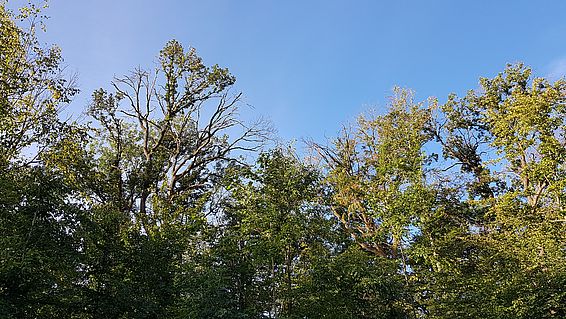21.07.2022 | Beate Kittl | News WSL
Researchers at the Swiss Federal Institute for Forest, Snow and Landscape Research WSL have calculated the water availability for trees in Swiss forest soils for the first time: Once the volume of Lake Walen is stored in the top two metres of soil. Their model also shows how serious past and current droughts are for the forest.
In the dry summer of 2018, the foliage of many trees in the Swiss forest turned yellow prematurely or fell off completely. There are now numerous studies on how plants react to such extreme events. But what happened to the water balance in the soil has so far remained in the dark. Now, for the first time, a WSL research team has been able to estimate the soil water storage in the Swiss forest, i.e. where and how much water is available that can be used by plants. This made it possible to analyse the extreme droughts of 2015 and 2018 more precisely.
The researchers used data from a network of 44 soil moisture measuring stations installed throughout Switzerland in soils of varying dryness. They integrated this data into a dynamic computational model that can model all water flows between soil, plant and atmosphere. "It can show how soil water reservoirs fill and empty depending on the weather and consumption by plants," says Katrin Meusburger, hydrologist at WSL and first author of a scientific article in Global Change Biology.
The forest is not a water thief ¶
If you imagine the maximum water storage capacity of forests down to a depth of two metres as a bucket, then the whole bucket holds about the water volume of Lake Walen. However, the quantities are very unevenly distributed throughout Switzerland; they vary by a factor of ten between the sites with the lowest water availability and those with the highest. The rooting depth of the plants also has an influence. This factor was included in the calculation model thanks to new data from WSL.
One aim of the study was to estimate the water consumption of trees in the dry summers of 2015 and 2018. "One might think that evaporation in the forest exacerbated the low water levels in water bodies or groundwater. But that is not the case," says Meusburger. The trees drastically reduced their evaporation (transpiration), by 23 per cent (2015) and 28 per cent (2018) respectively. During drought, trees close the pores in their leaves and needles, through which they absorb CO2 for photosynthesis, but also lose water. This happens at the expense of growth. The bottom line is that Swiss forest trees did not lose more water through transpiration than in other years.
2018 was worse than 2015
When the trees switch to water saving mode, the researchers speak of a transpiration deficit. With the new model, this key figure can be calculated. "We can quantify and also predict the extent of the drought from the plant's point of view," says Meusburger. "From a plant perspective, the 2018 drought was worse than that of 2015." The water-scarce period lasted from July to October, whereas in 2015 only July and August were critical.
The soil water availability simulated by the model corresponds well with the occurrence of early leaf discolouration in summer 2018 - and better than meteorological data alone. The new model thus perfectly complements the existing networks SwissSPOT and Treenet, both WSL projects that measure current water stress in soil and forest trees.
Meusburger would like to develop the model further so that in future it can inform foresters about how large and how full the soil water reservoir is in their forests. "We can show the invisible drought stress even before the threshold of wilting or leaf fall of the trees has been crossed," says Meusburger. To achieve this, she wants to increase the spatial resolution of the modelled maps from the current 500 metres to 25 metres. Foresters would be warned if their stands are weakened by drought, which can result in branch breakage, windthrow during storms and fungal or insect infestations.
Always up to date: Subscribe to WSL Newsletter
Contact ¶
Publications ¶
Copyright ¶
WSL and SLF provide the artwork for imaging of press articles relating to this media release for free. Transferring and saving the images in image databases and saving of images by third parties is not allowed.

